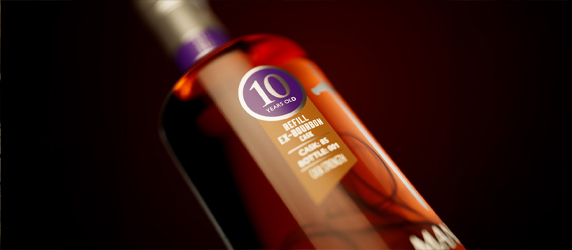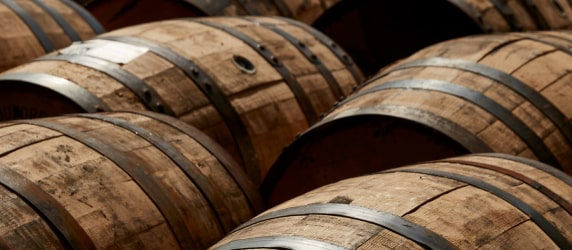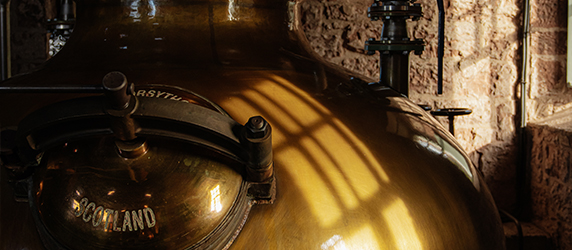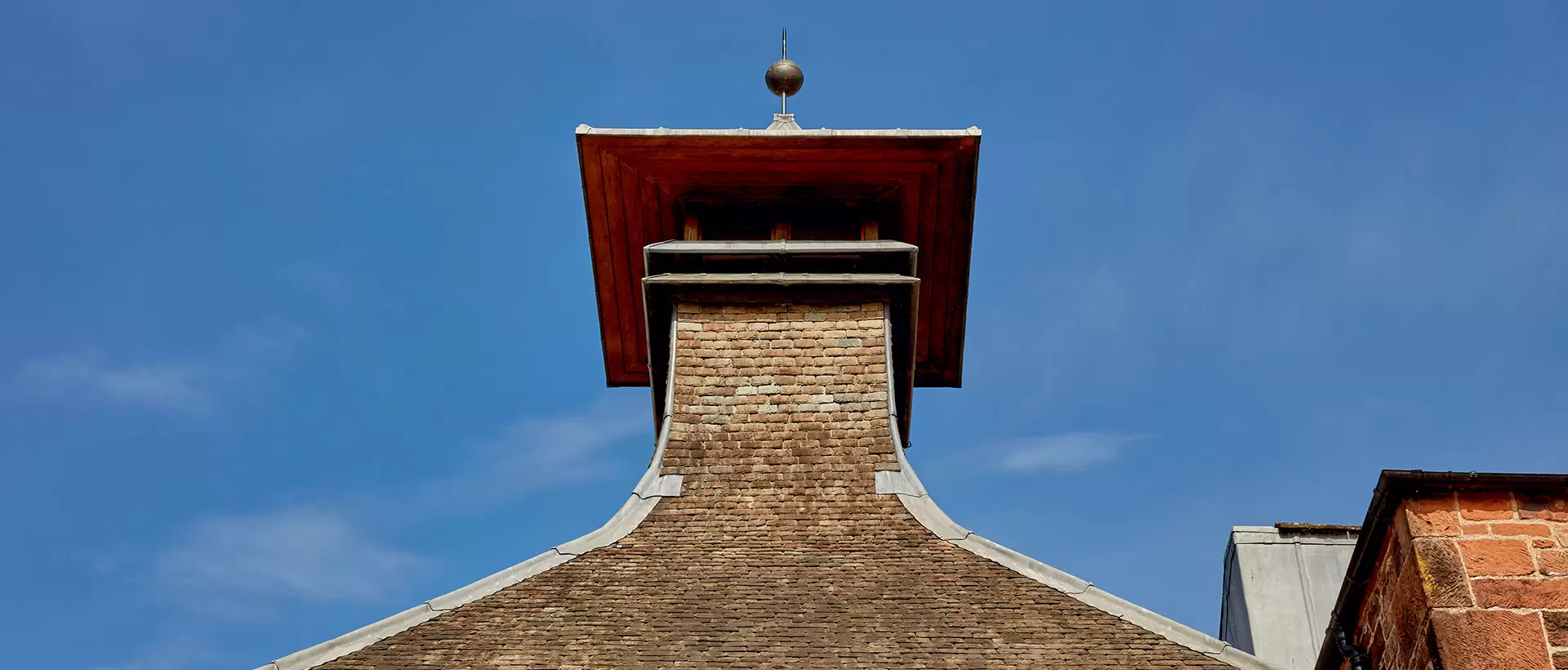Kilning
Charles Chree Doig and his iconic pagoda-roof malt kiln ventilators
Just as the biological processes associated with germination are triggered by increasing the moisture content of the barley grain, they are arrested by reducing the moisture content of green (germinated) malt from about 45% back down to 5%. Drying takes place in a malt kiln using warm air, hence the expression ‘kilning’. When dried to 5% moisture, malted barley may be stored for extended periods with minimal deterioration, it can be transported safely with minimal risk of physical damage and it can be readily milled into grist for subsequent mashing. Kilning also removes certain undesirable flavour components whilst desirable flavour compounds are created from endogenous flavour precursors and from extraneous sources such as peat smoke.
In the era when most Single Malt distilleries malted their own barley, they would have had a malt kiln. By the beginning of the 20th Century, many of the kilns in Scottish Single Malt distilleries would have been identifiable by their iconic, pagoda-roofed ventilators. As with traditional maltings, most of these natural-draught kilns are no longer used for their original purpose but they remain icons not just of the Single Malt Scotch whisky industry but also of Scotland.
The original design was created by Charles Chree Doig an architect cum engineer who worked out of Elgin (Morayshire) from 1882 until his death in 1918. Very few architectural designs are so stunning, so iconic, so immediately recognisable, so strongly associated with a particular industry and a particular country, so beautiful and yet, so practical. The design was first adopted when Doig was commissioned to carry out alterations to Dailuaine Distillery on Speyside in 1889. As part of the commission, he embellished the existing, inefficient kiln with his new pagoda roof ventilator. Sadly, the original Doig ventilator at Dailuaine was destroyed by fire in 1917.
Although the pagoda roof design was borrowed from Oriental architecture, it proved very effective in creating an up-draught through the damp malt bed almost irrespective of wind strength and direction, whilst keeping the rain off the drying malt. According to various archives, Doig worked on 56 different Scottish distilleries. However, this list is inaccurate because there’s at least one notable omission! Annandale Distillery in the very south of Scotland possesses a magnificent and beautifully restored pagoda-roofed Doig kiln that’s now used as the stunning main entranceway to the Distillery. The plans for Annandale Distillery were obtained from the Charles Doig Archive which is held at Elgin Library.
Many recently-built distilleries in Scotland and other countries sport faux Doig ventilators atop some building or other that never did and never will have anything to do with malt kilning. They’re a horrible pastiche of Doig’s original design that look absolutely absurd and otherwise offend the sensitivities of anybody who knows anything about Single Malt distilleries. It’s hugely disappointing that distillery architects of the modern era can’t think of anything more original to define their designs. (Perhaps someone should start a competition to identify the most absurd faux Doig ventilator.)
Early, natural-draught kilns were fired solely with peat in hand-stoked furnaces. In the days before the railways, peat was the preferred fuel, largely by default, because of its abundance across the length and breadth of Scotland. When the rail network expanded and coal could be transported more easily, kilns were often fired with a mix of anthracite and peat. This increased the temperature of the furnace and consequently, the speed and effectiveness of drying. The peat smoke (peat reek in Scots) created by burning peat contains a class of chemical compound known as phenolics. These are highly volatile and very potent odorants. Wet malt is very receptive to phenols, which absorb onto the surface of the damp barley grains during drying. Typically, about one third of the phenolics eventually transfer into the final whisky, giving it a characteristic smoky, antiseptic/medicinal character (usually but quite wrongly described as ‘peatiness’). The strength of the ‘peaty’ character depends on the amount of peated loaded onto the furnace when the barley is still damp. Such is the potency of these phenolic compounds that the amount in dry malt is measured in parts per million (ppm). A level of 5ppm would be barely detectable whereas 50ppm is very distinctive. In the 21st Century, the fact that peat was and still is used for drying green malt is a very happy coincidence because it utterly defines Scotch whisky and differentiates it from whisky made in every other country.
In spite of the brilliance and beauty of Doig’s design, natural-draught kilns are intrinsically inefficient because the airflow is relatively weak (unless it’s blowing a gale) and consequently the temperature of the furnace is relatively low because of the modest up-draught. This means that the malt beds are necessarily shallow (30cm) and temperature control is somewhat erratic. This makes it difficult to regulate and otherwise control the malt drying process. Lack of uniformity and lack of control, invariably has a knock-on negative effect on spirit yield.
Modern malt kilns are essentially an elaboration of the traditional kilns described above. Typically, large volumes of air are heated using oil or gas burners and drawn through the bed of green malt using powerful fans. This system would produce unpeated malt. At Port Ellen Maltings on Islay, peat smoke is generated by burning peats on an auxiliary furnace. The reek is introduced into the flow of hot air and up through the drying malt bed. Port Ellen’s peat furnaces, of which there are three, consume a staggering 6 tonnes of peat per kiln firing.
During kilning, it is of paramount importance that the enzymes, created naturally in germinating barley to convert starch into sugars, should be preserved intact. These enzymes (known as amylolytic enzymes) are reactivated during mashing, where they convert starch (amylose and amylopectin) into simple sugars (largely maltose). The temperature profile throughout the drying process has a profound effect on the viability of these enzymes and hence on the subsequent fermentability of the malt. A typical kilning cycle is 12 hours with an air temperature of 60oC, followed by 12 hours at 68oC and finally by 6 hours at 72oC. A modern maltings should produce malt for Scotch whisky with a fermentability of almost 90%. Fermentability (%F) is an index of the proportion of carbohydrate in the malt that is ultimately converted into alcohol during fermentation. This depends to a considerable extent on the viability of the amylolytic enzymes.
Dark malt, as used in brewing of ales, stouts and porters, is kilned to much higher temperatures where colour and flavour compounds are produced via non-enzymic browning (otherwise known as the Maillard reaction). However, these are undesirable in the production of Scotch whisky.
Modern maltings, such as those at Diageo’s Roseisle Distillery, use combined germination and kilning vessels (GKVs). These use space efficiently and reduce mechanical handling. At the end of the germination phase, the flow of humidified air through the GKV is stopped and replaced with warm air heated by the kiln burners.
These days, there is much greater awareness of the environmental issues associated with CO2 release when ancient, natural peat beds are disturbed, and when peat is subsequently burned. This needs to be reconciled against the fundamental importance of ‘peat flavour’ to Scotch Whisky. These and other issues regarding Annandale Distillery’s journey towards ‘net zero’, will be considered in subsequent technical releases.





